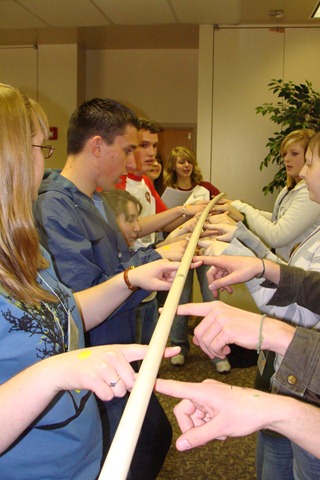There’s nothing like some good team building activities to get your family, friends or youth group working together and learning to depend on each other. Here’s a few of our favorites.
Helium Stick

Helium Stick is a team building game that will get your whole group laughing.
You play Helium Stick by lining up in two rows which face each other. Give them the Helium Stick- a long, thin, lightweight rod such as PVC pipe.
Ask the players to point their index fingers and hold their arms out. Lay the Helium Stick down on their fingers. Get the group to adjust their finger heights until the Helium Stick is horizontal and everyone’s index fingers are touching the stick. The challenge is to lower the Helium Stick to the ground.
NOTE: Each person’s fingers must be in touching the Helium Stick at all times. Pinching or grabbing the pole in not allowed – it must rest on top of fingers. Everyone’s fingers MUST be touching the Helium Stick!
It sounds easy but the stick seems to float to the top until the group works diligently to lower it to the ground. The trick is that the collective upwards pressure created by everyone’s fingers tends to be greater than the weight of the stick. As a result, the more a group tries, the more the stick tends to ‘float’ upwards.
I like this team building activity because it doesn’t require a lot of equipment or advance preparation. Hope it’s fun for your family.
Shark Island
Object: The entire group of 12- 20 people must board a 2-foot-square
Platform without anyone touching the ground around it.
Rules:
Everyone must remain on the platform for at least 10 seconds.
Everyone must have both feet off the ground.
Don’t put people more than two high.
Outcome:
Talk with the participants about teamwork, leadership and problem
solving skills. Emphasize that when someone feels that they have a
problem that is impossible to solve, that we can work together as a
family to help them find a solution. The most difficult part of this team building activity is getting the platform. If you are not able to get a platform you can tape your square on the floor and use a piece of carpet. It’s not quite as "thrilling" as a raised platform but can still be learning experience for your group.
![clip_image003[4] clip_image003[4]](http://familyreunionhelper.com/blog/wp-content/uploads/2012/11/clip_image0034_thumb.jpg) |
|||
The Couch Game
To play this game you need equal numbers of guys and girls, and form a team of each. You can ask girls to join the guys team if required and vice versa. You will also need a couch, which can be a real couch (which would replace four seats) or four adjacent seats or lawn chairs.
Write all of the players’ names onto pieces of paper and give one slip to each players. You become whoever your piece of paper says you are – don’t tell anyone whose name you have.
Everyone sits in a circle, alternate guy, girl, with four people on the couch and the rest on chairs. Have one extra, empty chair.
The object of the game is to get all your gender onto the couch. The person who is sitting with the empty chair to their left calls out a name, trying to get the opposite gender off the couch. The person with that piece of paper must stand up and move to the empty chair. They then swap their piece of paper with the caller. The next person to call is the one with now empty space to their left.
For example, say that Megan calls out "Jack". Grandpa has the name "Jack" on his paper so he moves to the empty chair and exchanges papers with Megan. So Megan now becomes "Jack". The person who was next to Grandpa now has an empty space on the left and is the next caller.
This goes on until one team has 4 of their own players on the couch.
This game starts off slowly and the games don’t last long but as the players catch on they will really start paying attention and memorizing the names people are exchanging.
Human Ladder
Object: The group lines up in two rows with each row facing the other. Each pair of persons (one from each row) facing each other will hold a dowel. (One 3′ x 1½’ dowel per person or a 3’ x 2×2 stick.) The object is to have one person standing at the end who will crawl across the horizontal ladder formed by the dowels. Caution: Make sure the dowels you have will support your group member’s weight! A volunteer starts at one end of the human ladder and climbs (horizontally) along the rungs of the ladder. After the climber passes over a rung of the ladder, team members "leap frog" to the front of the ladder, allowing the climber to continue climbing indefinitely.
Rules:
The climber must touch every rung of the ladder.
The group can hold the dowels in any manner desired— high, low, or forming a turn.
Do not hold the rungs above shoulder height.




![clip_image002[6] clip_image002[6]](http://familyreunionhelper.com/blog/wp-content/uploads/2012/11/clip_image0026_thumb.jpg)



